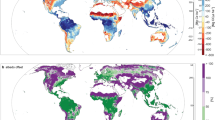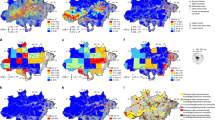Abstract
Surface albedo is a property of the Earth’s surface that provides an important climate regulating ecosystem service through the reflection of incoming solar radiation. In some regions, the cooling effect of higher albedo associated with snow-covered bare ground and young forests, compared to mature forests, can exceed the cooling effect of carbon sequestration from forest growth. Properly assigning an economic value to the net benefits of albedo-related shortwave radiative flux is therefore important in order to understand how these two ecosystem services may tradeoff under different scenarios and in different forests. Here we place an economic value on albedo-related shortwave radiation through the use of shadow prices derived from an integrated assessment model (DICE). We then examine the potential impact of this value on optimal forest rotation in the White Mountain National Forest (WMNF) in the state of New Hampshire, USA. Our results suggest that valuing albedo can shorten optimal rotation periods significantly compared to scenarios where only timber and carbon are considered. For instance, in spruce-fir stands, very short rotation periods of just 25 years become economically optimal when albedo is considered. We attribute this to the low productivity of the sites within the WMNF as well as the substantial snowfall that occurs in the area. Thus, in high latitude forests where snowfall is common and productivity is low, incorporating the valuation of albedo may lead to relatively short optimal rotation periods if the only ecosystem services considered are timber provisioning and climate regulation.




Similar content being viewed by others
References
Adams M, Loughry L, Plaugher L (2004) Experimental forests and ranges of the USDA Forest Service. Northeastern Research Station, p 178
Anderson RG, Canadell JG, Randerson JT et al (2011) Biophysical considerations in forestry for climate protection. Front Ecol Environ 9:174–182. doi:10.1890/090179
Bailey A, Hornbeck J, Campbell J, Eagar C (2003) Hydrometeorological database for Hubbard Brook Experimental Forest: 1955–2000, vol 305. US Department of Agriculture, Forest Service, Northeastern Research Station, p 36
Bala G, Caldeira K, Wickett M et al (2007) Combined climate and carbon-cycle effects of large-scale deforestation. Proc Natl Acad Sci U S A 104:6550–6555. doi:10.1073/pnas.0608998104
Betts RA (2000) Offset of the potential carbon sink from boreal forestation by decreases in surface albedo. Nature 408:187–190. doi:10.1038/35041545
Betts AK, Ball JH (1997) Albedo over the boreal forest. J Geophys Res 102:28901. doi:10.1029/96JD03876
Binkley CS, Van Kooten GC (1994) Integrating climatic change and forests: economic and ecologic assessments. Clim Chang 28:91–110. doi:10.1007/BF01094102
Birdsey RA (1996) Carbon storage for major forest types and regions in the conterminous United States. For Global Change 2:1–25
Bonan GB, Pollard D, Thompson SL (1992) Effects of boreal forest vegetation on global climate. Nature 359:716–718. doi:10.1038/359716a0
Bright RM, Strømman AH, Peters GP (2011) Radiative forcing impacts of boreal forest biofuels: a scenario study for Norway in light of albedo. Environ Sci Technol 45:7570–7580
Bright RM, Cherubini F, Strømman AH (2012) Climate impacts of bioenergy: inclusion of carbon cycle and albedo dynamics in life cycle impact assessment. Environ Impact Assess Rev 37:2–11. doi:10.1016/j.eiar.2012.01.002
Canadell JG, Raupach MR (2008) Managing forests for climate change mitigation. Science (NY) 320:1456–1457. doi:10.1126/science.1155458
Chen TS, Ohring G (1984) On the relationship between clear-sky planetary and surface albedos. J Atmos Sci 41:156–158
Cherubini F, Bright RM, Strømman AH (2012) Site-specific global warming potentials of biogenic CO 2 for bioenergy: contributions from carbon fluxes and albedo dynamics. Environ Res Lett 7:045902. doi:10.1088/1748-9326/7/4/045902
Claussen M, Brovkin V, Ganopolski A (2001) Biogeophysical versus biogeochemical feedbacks of large-scale land cover change. Geophys Res Lett 28:1011–1014. doi:10.1029/2000GL012471
Eckaus RS (1992) Comparing the effects of greenhouse gas emissions on global warming. Energy J 13:25–36
Energy USD of (2004) Draft technical guidelines for voluntary reporting of greenhouse gas program. Chapter 1, emission inventories. Part I: appendix. Washington, DC
Euskirchen ES, Goodstein E, Huntington HP (2013) An estimated cost of lost climate regulation services caused by thawing of the Arctic cryosphere. Ecol Appl 23:1869–1880. doi:10.1890/11-0858.1
Gutrich J, Howarth RB (2007) Carbon sequestration and the optimal management of New Hampshire timber stands. Ecol Econ 62:441–450. doi:10.1016/j.ecolecon.2006.07.005
Houspanossian J, Nosetto M, Jobbágy EG (2013) Radiation budget changes with dry forest clearing in temperate Argentina. Glob Chang Biol 19:1211–1222. doi:10.1111/gcb.12121
Jackson RB, Randerson JT, Canadell JG et al (2008) Protecting climate with forests. Environ Res Lett 3:044006. doi:10.1088/1748-9326/3/4/044006
Jin Y (2002) How does snow impact the albedo of vegetated land surfaces as analyzed with MODIS data? Geophys Res Lett 29:1374. doi:10.1029/2001GL014132
Kirschbaum MUF, Whitehead D, Dean SM et al (2011) Implications of albedo changes following afforestation on the benefits of forests as carbon sinks. Biogeosciences 8:3687–3696. doi:10.5194/bg-8-3687-2011
Klein AG, Stroeve J (2002) Development and validation of a snow albedo algorithm for the MODIS instrument. Ann Glaciol 34:8. doi:10.3189/172756402781817662
Kuusinen N, Kolari P, Levula J et al (2012) Seasonal variation in boreal pine forest albedo and effects of canopy snow on forest reflectance. Agric For Meteorol 164:53–60. doi:10.1016/j.agrformet.2012.05.009
Lee X, Goulden ML, Hollinger DY et al (2011) Observed increase in local cooling effect of deforestation at higher latitudes. Nature 479:384–387. doi:10.1038/nature10588
Lenton TM, Vaughan NE (2009) The radiative forcing potential of different climate geoengineering options. Atmos Chem Phys Discuss 9:5539–5561
Liski J, Pussinen A, Pingoud K et al (2011) Which rotation length is favourable to carbon sequestration? Can J For Res 31(11):2004–2013
Muñoz I, Campra P, Fernández-Alba AR (2010) Including CO2-emission equivalence of changes in land surface albedo in life cycle assessment. Methodology and case study on greenhouse agriculture. Int J Life Cycle Assess 15:672–681. doi:10.1007/s11367-010-0202-5
Nordhaus W (2008) A question of balance: weighing the options on global warming policies, the challenge of global warming: economic models and environmental policy. Yale University Press, Yale
Nordhaus WD (2010) Economic aspects of global warming in a post-Copenhagen environment. Proc Natl Acad Sci U S A 107:11721–11726. doi:10.1073/pnas.1005985107
Ollinger SV (2011) Sources of variability in canopy reflectance and the convergent properties of plants. New Phytol 189:375–394. doi:10.1111/j.1469-8137.2010.03536.x
Peterson U, Nilson T (1993) Successional reflectance trajectories in northern temperate forests. Int J Remote Sens 14:609–613
Price C, Willis R (2011) The multiple effects of carbon values on optimal rotation. J For Econ 17:298–306. doi:10.1016/j.jfe.2011.02.002
Proctor P, Heath L, Van Deusen PC et al (2005) COLE: A web-based tool for interfacing with forest inventory data. United States Department of Agriculture Forest Service, General Technical Report, 352:167
Schaaf CB, Gao F, Strahler AH et al (2002) First operational BRDF, albedo nadir reflectance products from MODIS. Remote Sens Environ 83:135–148. doi:10.1016/S0034-4257(02)00091-3
Schwaiger HP, Bird DN (2010) Integration of albedo effects caused by land use change into the climate balance: should we still account in greenhouse gas units? For Ecol Manag 260:278–286. doi:10.1016/j.foreco.2009.12.002
Sedjo RA, Wisniewski J, Sample AV, Kinsman JD (1995) The economics of managing carbon via forestry: assessment of existing studies. Environ Resour Econ 6:139–165. doi:10.1007/BF00691681
Sjølie HK, Latta GS, Solberg B (2013) Potential impact of albedo incorporation in boreal forest sector climate change policy effectiveness. Clim Pol 1–15. doi:10.1080/14693062.2013.786302
Stoleson SH, King DI, Yamasaki M et al (2011) Three decades of avian research on the Bartlett Experimental Forest, New Hampshire, U.S.A. For Ecol Manag 262:3–11
Thomas S, Dargusch P, Harrison S, Herbohn J (2010) Why are there so few afforestation and reforestation Clean Development Mechanism projects? Land Use Policy 27:880–887. doi:10.1016/j.landusepol.2009.12.002
Thompson MP, Adams D, Sessions J (2009) Radiative forcing and the optimal rotation age. Ecol Econ 68:2713–2720. doi:10.1016/j.ecolecon.2009.05.009
Van Doorn NS, Battles JJ, Fahey TJ et al (2011) Links between biomass and tree demography in a northern hardwood forest: a decade of stability and change in Hubbard Brook Valley, New Hampshire. Can J For Res 41:1369–1379. doi:10.1139/x11-063
Van Kooten GC, Binkley CS, Delcourt G (1995) Effect of carbon taxes and subsidies on optimal forest rotation age and supply of carbon services. Am J Agric Econ 77:365. doi:10.2307/1243546
Acknowledgments
The authors would like to thank Ross Jones, Ryan Bright, Tom O’Halloran, Liz Burakowski, and Mark Borsuk for their contributions and suggestions for this manuscript. This work was funded through the New Hampshire Experimental Program to Stimulate Cooperative Research (EPSCoR), support for which is provided by the National Science Foundation's Research Infrastructure Improvement Award # EPS 1101245. Additionally the authors thank the Forest Fridays group at the Environmental Studies Department at Dartmouth for comments on the research project. DAL would like to personally thank Queso.
Author information
Authors and Affiliations
Corresponding author
Electronic supplementary material
Below is the link to the electronic supplementary material.
Figure S1
A flowchart representing the modeling approach. Beginning in the top-left corner, land cover and geographic information data was collected for the study sites which were used to extract albedo values from two sources: the MODIS MCD43A product (Schaaf et al. 2002) and the MOD10A product (Klein and Stroeve 2002). Yearly radiative forcing values were calculated through measurements of latitude, atmospheric transmittance, the clearness of the atmosphere (KT) as measured by NASA’s Surface meteorology and Solar Energy (ISSCP) project (NASA 2009), and an albedo decay model. Forest growth parameters were generated from the United States Department of Agriculture (USDA) Forest Service Inventory and Analysis (FIA) database of stand information and carbon storage data was provided by the United States Department of Energy’s Carbon On Line Estimator (COLE) 1605 (b) reports (Proctor et al. 2005). (GIF 571 kb)
Figure S2
Shadow prices and net benefits (undiscounted) from albedo and carbon for a spruce-fir stand from the WMNF study site with a 25 year harvest rotation period. Albedo revenue increases after clear-cuts, whereas carbon revenue decreases significantly due to losses associated with harvest. (PDF 17 kb)
Table S1
Biological parameters associated with each of the four simulated forest stand types. Parameter values for each of the four simulated forest types (PDF 42 kb)
ESM 1
(DOC 570 kb)
Rights and permissions
About this article
Cite this article
Lutz, D.A., Howarth, R.B. Valuing albedo as an ecosystem service: implications for forest management. Climatic Change 124, 53–63 (2014). https://doi.org/10.1007/s10584-014-1109-0
Received:
Accepted:
Published:
Issue Date:
DOI: https://doi.org/10.1007/s10584-014-1109-0




